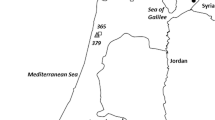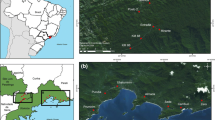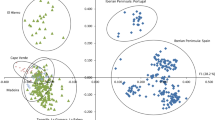Abstract
The greatest extent of genetic variation and outcrossing for Lycopersicon pimpinellifolium occurs in northern Peru. This is also the area most affected by EI Niño Southern Oscillation (ENSO). Using morphological and the molecular markers SSRs and AFLPs, we studied the genetic structure of L. pimpinellifolium populations collected after the ENSO event of 1997–1998. This was the most intense in the last century and caused a vast increase in the size of L. pimpinellifolium populations. Populations in the area surveyed were not regionally differentiated. We did not find any cline or eco-geographic association for genetic diversity, and positive correlations between genetic and geographic distances were found only at very short distances. Flooding and water streams caused by ENSO might have facilitated a periodical seed migration from distant areas. Gene flow between populations could then occur, facilitated by the increase in the population sizes of plants and pollinators and by the high levels of stigmatic exsertion. Results revealed a significant lack of heterozygotes in comparison with those expected in a panmictic population without consanguinity. A high degree of endogamy was found in all populations. In this context, endogamy can be explained by the occurrence of crosses between relatives rather than by autogamy. In an area intensely disturbed by ENSO, we found a population that had not been reported by earlier collectors in this region. This yellow-fruited population remained morphologically and molecularly differentiated from all L. pimpinellifolium and L. esculentum populations analyzed.
Similar content being viewed by others
References
A.E. Alvarez, C.C.M. van de Wiel, M.J.M. Smulders and B. Vosman, Use of microsatellites to evaluate genetic diversity and species relationships in the genus Lycopersicon. Theor. Appl. Genet. 103 (2001) 1283-1292
T. Areshchenkova and M.W. Ganal, Comparative analysis of polymorphism and chromosomal location of tomato microsatellite markers isolated from different sources. Theor. Appl. Genet. 104 (2002) 229-235
P. Arens, P. Odinot, A.W. van Exuden, P. Lindhout and B. Vosman, GATA- and GACA-repeats are not evenly distributed throughout the tomato genome. Genome 38 (1995) 84-90
E. Baudry, C. Kerdelhue, H. Innan and W. Stephan, Species and recombination effects on DNA variability in the tomato genus. Genetics 158 (2001) 1725-1735
K. Belkhir, P. Borsa, L. Chikhi, N. Ranfaste and T. Bonhomme, Genetix.4.04. Logiciel sous windowsTM pour la genetiqué des populations. Montpellier: Laboratoire GénomePopulations, Interactions, Université de Montpellier II (1996–2002).
G. Bonnema, P. van der Berg and P. Lindhout, AFPLs mark different genomic regions compared with RFLPs: a case study in tomato. Genome 45 (2002) 217-221
G.M.M. Bredemeijer, R.J. Cooke, M.W. Ganal, R. Peeters, P. Isaac, Y. Noordijk, S. Rendell, J. Jackson, M. S. Röder, K. Wendehake, M. Dijcks, M. Amelaine, V. Wickaert, L. Bertrand and B. Vosman, Construction and testing of a microsatellite database containing more than 500 tomato varieties. Theor. Appl. Genet. 105 (2002) 1019-1026
P. Broun and S.D. Tanksley, Characterization and genetic mapping of single repeat sequences in the tomato genome. Mol. Gen. Genet. 250 (1996) 39-49
L.L. Cavalli-Sforza and A.W.F. Edwards, Phylogenetic analysis: models and estimation procedures. Evolution 32 (1967) 550-570
A.H. Del Rio and J.B. Bamberg, Lack of association between genetic and geographical origin characteristics for the wild potato Solanum sucrense. Amer. J. Potato Res. 79 (2002) 335-338
L.R. Dice, Measures of the amount of ecologic association between species. Ecology 26 (1945) 297-302
R.A. Ennos, Estimating the relative rates of pollen and seed migration among plant populations. Heredity 72 (1994) 250-259
B. Escofier and J. Pagés, Analyses factorielles simples et multiples. Paris: Dumond (1990).
M. Ferriol, B. Picó and F. Nuez, Genetic diversity of a germplasm collection of Cucurbita pepo using SRAP and AFLP markers. Theor. Appl. Genet. 107 (2003) 271-282
L. Galiana-Balaguer, S. Roselló, J.M. Herrero-Martínez, A. Maqueira and F. Nuez, Determination of L-ascorbic acid in Lycopersicon fruits by capillary zone electrophoresis. Anal. Biochem. 296 (2001) 218-224
M.S. Georgiady, R.M. Whitkus and E.M. Lord, Genetic analysis of traits distinguishing outcrossing and self- pollinating forms of currant tomatoLycopersicon pimpinellifolium (Juss.) Mill. Genetics 161 (2002) 333-344
J.P.W. Haanstra, C. Wye, H. Verbakel, F. Meijer-Dekens, P. Berg Van den, P. Odinot, A.W. Van Exuden, S. Tanksley, P. Lindhout and J. Peleman, An integrated high-density RFLP–AFLP map of tomato based on two Lycopersicon esculentum×L. pennellii F2 populations. Theor. Appl. Genet. 99 (1999) 254-271
C. He, V. Poysa and K. Yu, Development and characterization of simple sequence repeat (SSR) markers and their use in determining relationship among Lycopersicon esculentum cultivars. Theor. Appl. Genet. 106 (2003) 363-373
M. Holle, C.M. Rick and D.G. Hunt, Catalog of collections of green-fruited Lycopersicon species and Solanum pennellii found in watersheds of Peru. TGC Report 28 (1978) 50-78
Descriptors for tomato (Lycopersicon). Rome: International Plant Genetic Resources Institute (1996).
S. Jaramillo and M. Baena, Material de apoyo a la capacitación en conservación ex situ de recursos fitogenéticos. Cali: Instituto Internacional de Recursos Fitogenéticos (2000).
N. Mantel, The detection of disease clustering and a generalized regression approach. Cancer Res. 27 (1967) 209-220
J.A. Marshall, S. Knapp, M.R. Davey, J.B. Power, E.C. Cocking, M.D. Bennett and A.V. Cox, Molecular systematics of Solanum section Lycopersicon (Lycopersicon) using the nuclear ITS rDNA region. Theor. Appl. Genet. 103 (2001) 1216-1222
Matthiolus P.A. 1544. Di Pedacio Dioscoride Anarzabeo libri cinque della historia et material medicinale trodotte in lingua volgare Italiana. Venice.
C.E. McGregor, R. Treuren van, R. Hoekstra and T.J.L. van Hintum, Analysis of the wild potato germplasm of the series Acaulia with AFLPs: implications for ex situ conservation. Theor. Appl. Genet. 104 (2002) 146-156
J.C. Miller and S.D. Tanksley, RFLP analysis of phylogenetic relationships and genetics variation in the genus Lycopersicon. Theor. Appl. Genet. 80 (1990) 437-448
C. H. Muller, A revision of the genus Lycopersicon. USDA Misc. Publication 382 (1940) 29
M. Nei, Analysis of gene diversity in subdivided populations. Proc. Nat. Acad. Sci. USA 70 (1973) 3321-3323
M. Nei, F-statistic and analysis of gene diversity in subdivided populations. Ann. Hum. Genet. 41 (1977) 225-233
F. Nuez, J. Prohens and J.M. Blanca, Relationships, origin, and diversity of Galapagos tomatoes: implications for the conservation of natural populations. Am. J. Bot. 91 (2004) 86-99
C.M. Rick and R.T. Chetelat, Utilization of related wild species for tomato improvement. Acta Hortic. 412 (1995) 21-38
C.M. Rick and M. Holle, Andean Lycopersicon esculentum var. cerasiforme: genetic variation and its evolutionary significance. Econ. Bot. 44 (1990) 69-78
C.M. Rick, J.F. Fobes and M. Holle, Genetic variation in Lycopersicon pimpinellifolium. Evidence of evolutionary change in mating systems. Plant Syst. Evol. 127 (1977) 139-170
C.M. Rick, M. Holle and R.W. Thorp, Rates of cross-pollination in Lycopersicon pimpinellifolium: Impact of genetic variation in floral characters. Plant Syst. Evol 129 (1978) 31-44
C.M. Rick, H. Laterrot and J. Philouze, A revised key for the Lycopersicon species. TGC Report 40 (1990) 31
F.J. Rohlf, NTSYS-pc: numerical taxonomy and multivariate analysis systemversion 2.0, user guide. New York: Exeter Software (1998).
V. Saliba-Colombani, M. Causse, L. Gervais and J. Philouze, Efficiency of RFLP, RAPD, and AFLP markers for the construction of an intraspecific map of the tomato genome. Genome 43 (2000) 29-40
P.E. Smouse and R. Peakall, Spatial autocorrelation analysis of the individual multiallele and multilocus genetic structure. Heredity 82 (1999) 561-573
M.J.M. Smulders, G. Bredemeijer, W. Rus-Kortekaas, P. Arens and B. Vosman, Use of short microsatellites from database sequences to generate polymorphisms among Lycopersicon esculentum cultivars and accessions of other Lycopersicon species. Theor. Appl. Genet. 97 (1997) 264-272
D.M. Spooner, I.E. Peralta and S. Knapp, Comparison of AFLPs with other markers for phylogenetic inference in wild tomatoes [Solanum L. section Lycopersicon (Mill.) Wettst.]. Taxon 54 (2005) 43-61
N. Takezaki and M. Nei, Genetic distances and reconstruction of phylogenetics trees from microsatellites DNA. Genetics 144 (1996) 389-399
I.B. Taylor, Biosystematics of the tomato. In: J.G. Atherton and J. Ridich (eds.) The Tomato Crop. A Scientific Basis for Improvement. London and New York: Chapman and Hall (1986) pp. 1-34
Guidelines for the conduct of tests for distinctness, homogeneity and stability. Tomato (Lycopersicon lycopersicum (L.) Karst. ex Farw.). Geneva: UPOV (1976).
J. Villand, P.W. Skroch, T. Lai, P. Hanson, C.G. Kuo and J. Nienhuis, Genetic variation among tomato accessions from primary and secondary centres of diversity. Crop Sci. 38 (1998) 1339-1347
S.J. Warnock, Natural habitats of Lycopersicon species. HortScience 26 (1991) 446-471
B.S. Weir and C.C. Cockerham, Estimating F-statistics for the analysis of population structure. Evolution 38 (1984) 1358-1370
M.P. Widrlechner, Variation in the breeding system of Lycopersicon pimpinellifolium: implication for germplasm maintenance. Plant Gen. Res. Newsl. 70 (1987) 38-43
C.E. Williams and D.A. St Clair, Phenetic relationships and levels of variability detected by restriction fragment length polymorphism and random amplified polymorphic DNA analysis of cultivated and wild accessions of L. esculentum. Genome 36 (1993) 619-630
The 1997–98 El Niño: a scientific and technical retrospective. Geneva: WMO No. 905 (1999).
F.C. Yeh, R.C. Yang, T.B.J. Boyle, Z.H. Ye and J.X. Mao, POPGENEthe user-friendly shareware for population genetic analysis. Alberta: Molecular Biology and Biotechnology CentreUniversity of Alberta (1997).
Author information
Authors and Affiliations
Rights and permissions
About this article
Cite this article
Sifres, A., Picó, B., Blanca, J.M. et al. Genetic Structure of Lycopersicon pimpinellifolium (Solanaceae) Populations Collected after the ENSO Event of 1997–1998. Genet Resour Crop Evol 54, 359–377 (2007). https://doi.org/10.1007/s10722-005-5725-4
Received:
Accepted:
Published:
Issue Date:
DOI: https://doi.org/10.1007/s10722-005-5725-4




